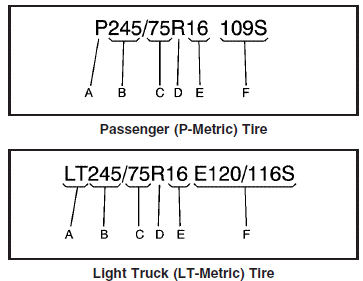Tire Size
The following examples show the different parts of a tire size.

(A) Passenger (P-Metric) Tire: The United States version of a metric tire sizing system. The letter P as the first character in the tire size means a passenger vehicle tire engineered to standards set by the U.S. Tire and Rim Association.
(A) Light Truck (LT-Metric) Tire: The United States version of a metric tire sizing system. The letters LT as the first two characters in the tire size means a light truck tire engineered to standards set by the U.S. Tire and Rim Association.
(B) Tire Width: The three-digit number indicates the tire section width in millimeters from sidewall to sidewall.
(C) Aspect Ratio: A two-digit number that indicates the tire height-to-width measurements.
For example, if the tire size aspect ratio is 75, as shown in item C of the light truck (LT-Metric) tire illustration, it would mean that the tire’s sidewall is 75 percent as high as it is wide.
(D) Construction Code: A letter code is used to indicate the type of ply construction in the tire. The letter R means radial ply construction; the letter D means diagonal or bias ply construction; and the letter B means belted-bias ply construction.
(E) Rim Diameter: Diameter of the wheel in inches.
(F) Service Description: The service description indicates the load range and speed rating of a tire. The load index can range from 1 to 279.
Speed ratings range from A to Z.
See also:
Fuels in Foreign Countries
Never use leaded gasoline or any other fuel not recommended in the previous text
on fuel. Costly repairs caused by use of improper fuel would not be covered by the
vehicle warranty.
To check the ...
Securing the Child Within the ChildRestraint
There are several systems for securing the child
within the child restraint. One system, the
three-point harness, has straps that come down
over each of the infant’s shoulders and buckle
togethe ...
What to Use
Use a mixture of one-half clean, drinkable water
and one-half DEX-COOL® coolant. If you use
this coolant mixture, you do not need to add
anything else.
CAUTION:
Adding only plain water to your ...


